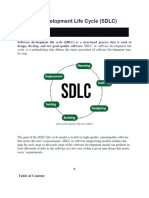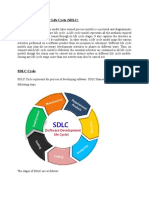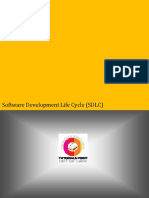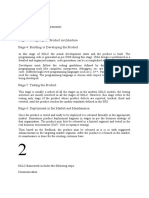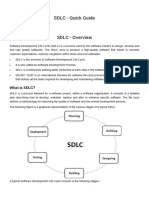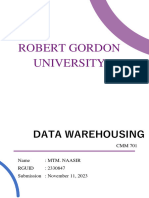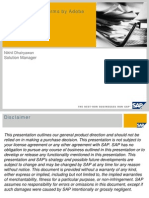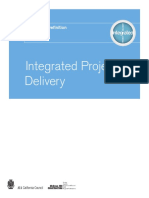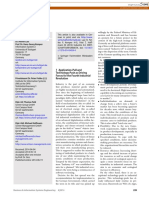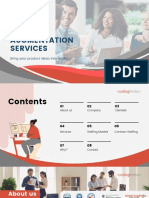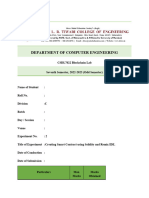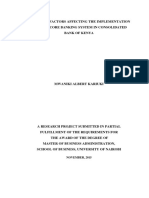Sy BCS Software Engineering Unit-2
Uploaded by
farukhSy BCS Software Engineering Unit-2
Uploaded by
farukhSoftware Development Life Cycle (SDLC)
What is the Software Development Life Cycle (SDLC)?
SDLC is a process followed for software building within a software organization. SDLC consists of a
precise plan that describes how to develop, maintain, replace, and enhance specific software. The life
cycle defines a method for improving the quality of software and the all-around development process.
Stages of the Software Development Life Cycle
SDLC specifies the tasks to be performed at various stages by a software engineer or developer. It
ensures that the end product is able to meet the customer's expectations and fits within the overall
budget. Hence, it's vital for a software developer to have prior knowledge of this software
development process. SDLC is a collection of these six stages, and the stages of SDLC are as
follows:
The SDLC Model involves six phases or stages while developing any software.
Stage 1: Planning and Requirement Analysis
Planning is a crucial step in everything, just as in software development. In this same
stage, requirement analysis is also performed by the developers of the organization. This is attained
from customer inputs, and sales department/market surveys.
The information from this analysis forms the building blocks of a basic project. The quality of the
project is a result of planning. Thus, in this stage, the basic project is designed with all the available
information.
Stage 2: Defining Requirements
In this stage, all the requirements for the target software are specified. These requirements get
approval from customers, market analysts, and stakeholders.
This is fulfilled by utilizing SRS (Software Requirement Specification). This is a sort of document that
specifies all those things that need to be defined and created during the entire project cycle.
Stage 3: Designing Architecture
SRS is a reference for software designers to come up with the best architecture for the software.
Hence, with the requirements defined in SRS, multiple designs for the product architecture are
present in the Design Document Specification (DDS).
This DDS is assessed by market analysts and stakeholders. After evaluating all the possible factors,
the most practical and logical design is chosen for development.
Stage 4: Developing Product
At this stage, the fundamental development of the product starts. For this, developers use a specific
programming code as per the design in the DDS. Hence, it is important for the coders to follow the
protocols set by the association. Conventional programming tools like compilers, interpreters,
debuggers, etc. are also put into use at this stage. Some popular languages like C/C++, Python,
Java, etc. are put into use as per the software regulations.
Stage 5: Product Testing and Integration
After the development of the product, testing of the software is necessary to ensure its smooth
execution. Although, minimal testing is conducted at every stage of SDLC. Therefore, at this stage, all
the probable flaws are tracked, fixed, and retested. This ensures that the product confronts the quality
requirements of SRS.
Documentation, Training, and Support: Software documentation is an essential part of the
software development life cycle. A well-written document acts as a tool and means to information
repository necessary to know about software processes, functions, and maintenance. Documentation
also provides information about how to use the product. Training in an attempt to improve the current
or future employee performance by increasing an employee's ability to work through learning, usually
by changing his attitude and developing his skills and understanding.
Stage 6: Deployment and Maintenance of Products
After detailed testing, the conclusive product is released in phases as per the organization’s strategy.
Then it is tested in a real industrial environment. It is important to ensure its smooth performance. If it
performs well, the organization sends out the product as a whole. After retrieving beneficial feedback,
the company releases it as it is or with auxiliary improvements to make it further helpful for the
customers. However, this alone is not enough. Therefore, along with the deployment, the product's
supervision.
What is the need for SDLC?
SDLC is a method, approach, or process that is followed by a software development organization
while developing any software. SDLC models were introduced to follow a disciplined and systematic
method while designing software. With the software development life cycle, the process of software
design is divided into small parts, which makes the problem more understandable and easier to solve.
SDLC comprises a detailed description or step-by-step plan for designing, developing, testing, and
maintaining the software.
How does SDLC Address Security?
A frequent issue in software development is the delay of security-related tasks until the testing phase,
which occurs late in the software development life cycle (SDLC) and occurs after the majority of
crucial design and implementation has been finished. During the testing phase, security checks may
be minimal and restricted to scanning and penetration testing, which may fail to identify more
complicated security flaws.
Security issue can be address in SDLC by following DevOps. Security is integrated throughout the
whole SDLC, from build to production, through the use of DevSecOps. Everyone involved in the
DevOps value chain have responsibility for security under DevSecOps.
Real Life Example of SDLC
Developing a banking application using SDLC:
Planning and Analysis: During this stage, business stakeholders' requirements about the
functionality and features of banking application will be gathered by program managers and
business analysts. Detailed SRS (Software Requirement Specification) documentation will be
produced by them. Together with business stakeholders, business analysts will analyze and
approve the SRS document.
Design: Developers will receive SRS documentation. Developers will read over the
documentation and comprehend the specifications. Web pages will be designed by designers.
High level system architecture will be prepared by developers.
Development: During this stage, development will code. They will create the web pages and
APIs needed to put the feature into practice.
Testing: Comprehensive functional testing will be carried out. They will guarantee that the
banking platform is glitch-free and operating properly.
Deployment and Maintenance: The code will be made available to customers and deployed.
Following this deployment, the customer can access the online banking. The same
methodology will be used to create any additional features.



